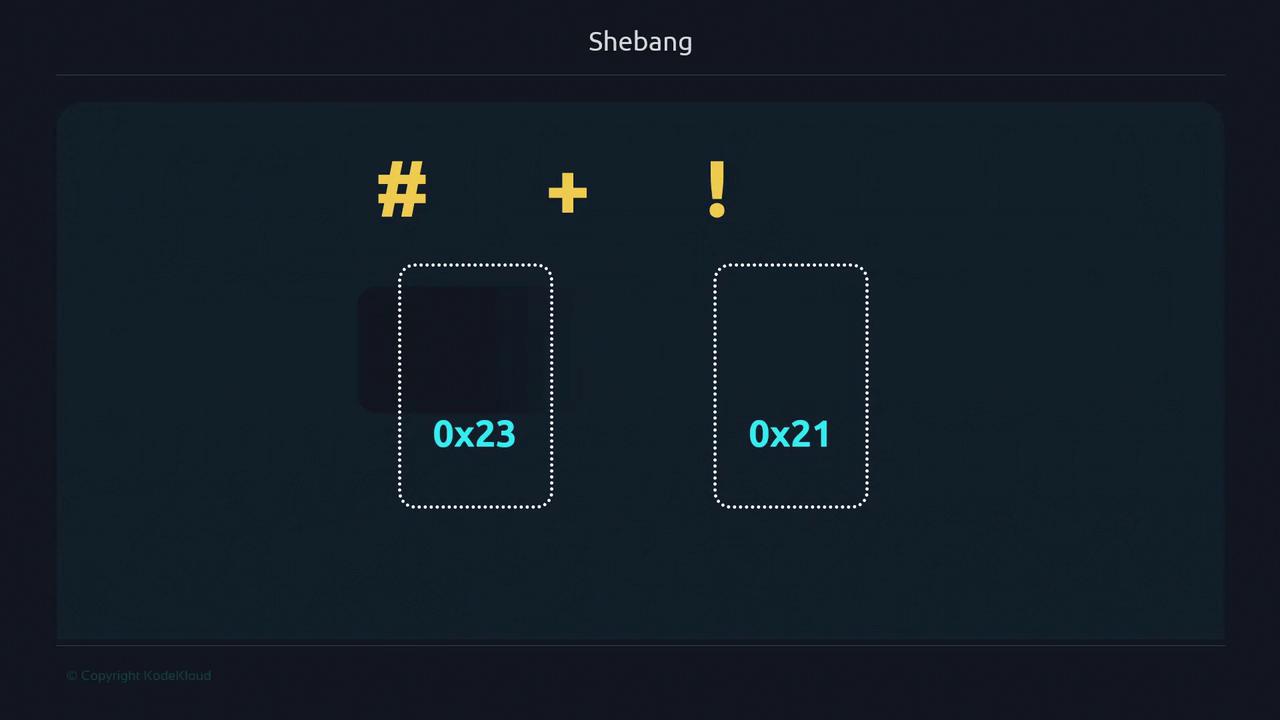Advanced Bash Scripting
Refresher
Shebang
In this lesson, we’ll explore how the shebang (#!) directive affects script execution and portability. You will learn to:
- Remove the shebang from a script and analyze its behavior.
- Trace system calls with
straceto observe kernel execution. - Demonstrate shebangs across different shells (e.g., Bash, C shell).
- Adopt a modern, portable shebang and avoid common pitfalls.

The Shebang Analogy
Think of yourself as a polyglot translator facing an ancient manuscript. Each dialect (shell) has subtle differences. A shebang acts like a translator’s guide, ensuring your script is read by the intended interpreter. Without it, your login shell takes over, which may lead to unexpected behavior and portability issues.
Example of a classic shebang:
#!/bin/bash
The term shebang blends “hash” (#, 0x23) with “bang” (!, 0x21), sometimes pronounced “shbang.”
What Happens Without a Shebang?
Create noshebang.sh without a shebang:
# noshebang.sh
WORDS="I don't have a shebang and I still run"
for word in ${WORDS}; do
if [[ 2 < 3 ]]; then
echo "${word}"
fi
done
Make it executable and run:
chmod +x noshebang.sh
./noshebang.sh
# Each word prints because Bash (your login shell) interprets it
echo $SHELL
# /bin/bash
Relying on the parent shell works locally but isn't portable—other environments may default to /bin/sh, which lacks Bash-specific features.
Tracing Kernel Execution with strace
Compare a script without and with a shebang:
# shebang.sh
#!/bin/bash
WORDS="I don't have a shebang and I still run"
for word in ${WORDS}; do
if [[ 2 < 3 ]]; then
echo "${word}"
fi
done
Trace your shell’s PID ($$) in the background:
sudo strace -Tfp $$ 2>&1 | grep -E 'execve' &
Run both scripts:
./noshebang.sh
./shebang.sh
# [pid …] execve("./shebang.sh", ["./shebang.sh"], …) = 0
# Script runs successfully under /bin/bash
When the kernel detects #! followed by a valid interpreter, it invokes that program directly.

Using a Different Shell: C Shell Example
C shell (csh) syntax is distinct. Running a C shell script under Bash without a shebang will fail:
# is_csh.sh
set x = 'a'
if ($x == 'a') then
echo "running on a c shell csh"
endif
chmod +x is_csh.sh
./is_csh.sh
# -bash: ./is_csh.sh: /bin/csh: syntax error: unexpected end of file
Add the correct shebang:
#!/bin/csh
set x = 'a'
if ($x == 'a') then
echo "running on a c shell csh"
endif
./is_csh.sh
# running on a c shell csh

Modern, Portable Shebang
Hardcoding interpreter paths can break across systems. Instead, use:
#!/usr/bin/env bash
This invokes env to locate bash via your PATH, enhancing cross-platform compatibility.
Note
Using #!/usr/bin/env bash avoids assumptions about interpreter locations, but it relies on env being in /usr/bin.
| Shebang Line | Description | Pros & Cons |
|---|---|---|
| #!/bin/bash | Direct path to Bash | Fast invocation, but not portable if Bash is installed elsewhere. |
| #!/usr/bin/env bash | Finds Bash in PATH via env | Portable across environments, depends on a correct PATH. |
Demo: Bash Version Features
Create bash_versions.sh:
#!/usr/bin/env bash
echo "Current Unix timestamp (integer): ${EPOCHSECONDS}"
echo "Current Unix timestamp (floating-point): ${EPOCHREALTIME}"
On macOS default Bash (v3):
bash --version
./bash_versions.sh
# Current Unix timestamp (integer):
# Current Unix timestamp (floating-point):
After upgrading to Bash 5.2 (e.g., via Homebrew) and updating your PATH:
bash --version
./bash_versions.sh
# Current Unix timestamp (integer): 1679282700
# Current Unix timestamp (floating-point): 1679282700.176761
By leveraging #!/usr/bin/env bash, you automatically use the most appropriate Bash installed on your system.
Caveats & Recommendations
Minimal environments (e.g., BusyBox) may not include
bash. Verify available interpreters in/etc/shells:cat /etc/shells # /bin/sh # /bin/bash # /sbin/nologin …
Warning
If /usr/bin/env or your chosen shell isn’t available, scripts will fail. Always confirm interpreter paths before deployment.
- Select a shebang that aligns with your target environment and installed shells.
For all remaining course examples, we’ll use:
#!/usr/bin/env bash
Adjust this line if your system requires a different interpreter path.
Links and References
Watch Video
Watch video content
Practice Lab
Practice lab